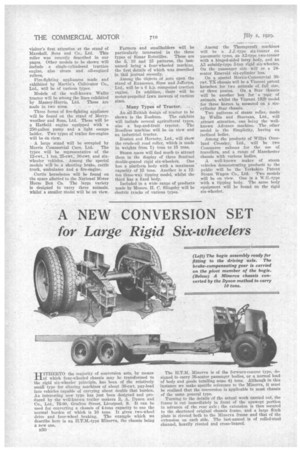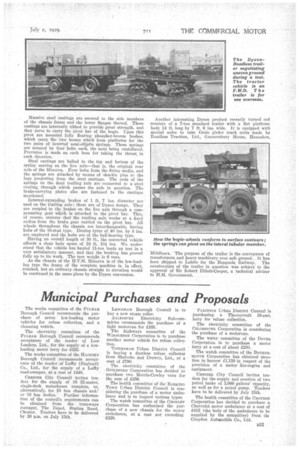A NEW CONVERSION SET for Large Rigid Six-wheelers
Page 56

Page 57

If you've noticed an error in this article please click here to report it so we can fix it.
HITHERTO the majority of conversion sets, by means _Lief which four-wheeled chassis may be transformed to the rigid six-wheeler piinciple, has been of the relatively small type for alterity,b machines of about 30-cwt. pay-load into vehicles capable of carrying about double that burden. An interesting new type has just been designed and produced by the well-known trailer makers It. A. Dyson and Co., Ltd., 76-SO, Grafton Street, Liverpool, S. It can be used for converting a chassis of 4-tons capacity to one the normal burden of which is 10 tons. It gives two-wheel drive and four-wheel braking. The exam_ple which we describe here is an H.T.M.-type Minerva, the chassis being a new one.
B30 The H.T.M. Minerva is of the forwara-controi type, to carry 36-seater passenger bodies, or a normal load obody and goods totalling some 41 tons. Although in this instance we make specific reference to the Minerva, it must be realized that the conversion is applicable to most chassis of the same general type.
Turning to the details of the actual work carried out, the frame is cut immediately in front of the upswept portion in advance of the rear axle ; the extension is then secured to the shortened original chassis frame, and a large flitch plate is riveted both to the Minerva frame and that of the extension on each side. The last-named is of rolled,steel channel, heavily riveted and cross-braced. Massive steel castings are secured to the side members of the chassis frame and the lower flanges thereof. These castings are internally ribbed to provide great strength, and they serve to carry the pivot bar of the bogie. Upon this pivot are mounted fully floating phosphor-bronze bushes, which carry the two bosses which form platforms for the two pairs of inverted semi-elliptic springs. These springs are secured by four bolts each, the nuts being castellatel Provision is made on each boss for taking the thrust in each direction.
Steel castings are bolted to the top and bottom of the spring seating on the live axle—that is, the original rear axle of the Minerva. Four bolts form the fixing media, and the springs are attached by means of shackle pins to the Jugs projecting from the .stepl castings. The ends of the springs on the dead trailing axle are connected to a steel costing, through which passes the axle in question. The brake-carrying plates also are fastened to the castings mentioned.
Internal-expanding brakes of 1 ft. 7 ins, diameter are used on the trailing axle; these are of Dyson design. They are coupled to the brakes on the live axle through a compensating gear which is attached to the pivot bar. This, of course, ensures that the trailing axle works at a fixed radius from the brake gear carried on the pivot bar. All wheels throughout the chassis are interchangeable, haviug hubs of the 10-stud type. Dunlop tyres of 40 ins. by 8 ins. are employed and the hubs are of the ball-bearing type.
Having an overall length of 30 ft., the converted vehicle affords a clear body space of 24 ft.. 10i ins. We understand that the vehicle has hauled 11-ton loads on test in a very satisfactory manner, and that the braking has proved fully up to its work. The tare weight is 6 tons.
As the chassis of the H.T.M. Minerva is of the low-loading type the frame of the complete machine is, in effect, cranked, but an ordinary chassis straight in elevation would be continued in the same'plane by the Dyson conversion. Another interesting Dyson product recently turned out consists of a 7-ton standard trailer with a flat platform body 14 ft. long by 7 ft. 6 ins. wide. It is equipped with special axles to take Orolo girder track units made by Roadless Traction, Ltd., Gunnersbury House, Hounslow,
Middlesex, The purpose of the trailer is the conveyance of transformers and heavy machinery over, soft ground. It has been shipped to Labito for the Benguela, Railway. The construction of the trailer in question was subject to the approval of Sir Robert Elliott-Cooper, a technical adviser to H.M. Government.




















































































































